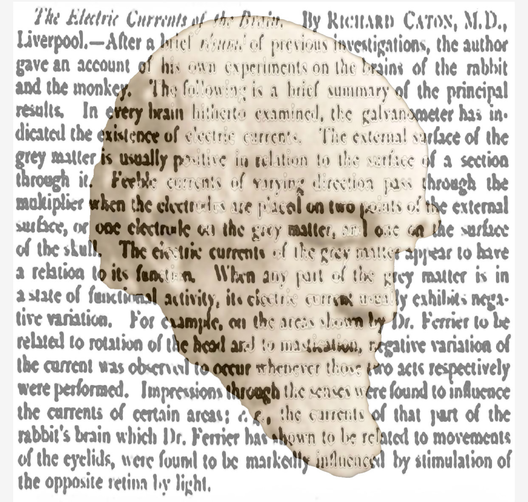Richard Caton1842–1926
Caton published relatively little, but the abstracts of his experiments on electrical recording from the brain generated waves in brain research. He presented the preliminary account of his experiments to a meeting of the British Medical Association at Edinburgh in 1875. Caton is shown in the abstract of his presentation to that meeting; it was on the electrical currents in the brain of rabbit and monkey. It reads: “every brain hitherto examined, the galvanometer has indicated the existence of electric currents. The external surface of the grey matter is usually positive in relation to the surface of a section through it. Feeble currents of varying direction pass through the multiplier when the electrodes are placed on two points of the external surface of the skull. The electric currents of the grey matter appear to have a relation to its functions. When any part of the grey matter is in a state of functional activity, its electric current usually exhibits negative variation. For example, on the areas shown by Dr. Ferrier to be related to rotation of the head and to mastication, negative variation of the current was observed to occur whenever those two acts respectively were performed. Impressions through the senses were found to influence the currents of certain areas, e.g., the currents of that part of the rabbit's brain which Dr. Ferrier has shown to be related to movements of the eyelids, were found to be markedly influenced by stimulation of the opposite retina by light.” This research provided the foundations upon which Berger could construct his investigations of the alpha rhythm in humans. Indeed, Berger was one of the few workers who both appreciated and cited Caton’s research: “has already (1874) published experiments on the brains of dogs and apes in which bare unipolar electrodes were placed either on the cerebral cortex and the other on the surface of the skull. The currents were measured by a sensitive galvanometer. There were found distinct variations in current, which increased during sleep and with the onset of death strengthened, and after death became weaker and then completely disappeared. Caton could show that strong current variations resulted in brain from light shone into the eyes, and he speaks already of the conjecture that under the circumstances these cortical currents could be applied to localization within the cortex of the brain.” It is likely that Caton had been stimulated by Ferrier’s papers on the functions of the brain, and he cites Ferrier in the text which carries his portrait.
